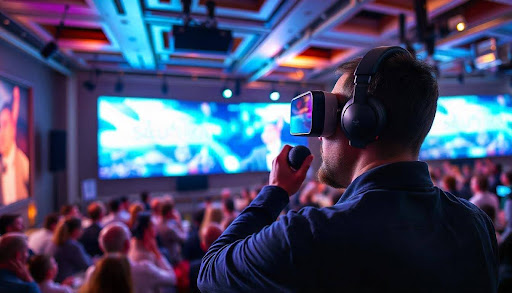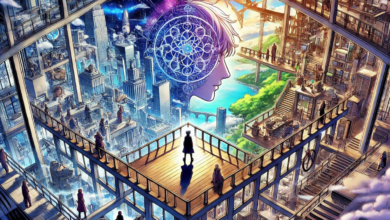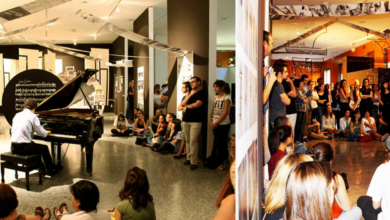How 360-Degree Audio-Visual Experiences Boost Audience Retention

In today’s digital age, capturing audience attention is increasingly challenging. To stand out, businesses and creators are turning to 360-degree audio-visual experiences, which combine immersive visuals with spatial audio to deliver unparalleled engagement. These environments, powered by technologies like VR and AR, merge sight, sound, and interaction, drawing users into the narrative and making them feel part of the action. By creating realistic, multisensory experiences, 360-degree content is transforming audience retention and reshaping the future of engagement.
1. Full Immersion: A New Level of Engagement
Breaking the One-Dimensional Barrier
Traditional media confines viewers to a passive role, merely observing the action. In contrast, 360-degree content transforms viewers into participants, allowing them to explore environments from multiple perspectives. By controlling their viewpoint—through head movements, touchscreens, or physical motion—users experience a level of interaction that fosters deeper engagement.
The Power of Spatial Audio
When paired with spatial audio, where sounds originate from specific points in the environment, 360-degree content creates a fully immersive experience. This synergy of visuals and sound mimics real-world perception, making the experience more tangible, engaging, and captivating.
To ensure these immersive qualities are captured flawlessly, audio visual installations play a pivotal role. These installations ensure that both sound and visuals are expertly synchronized, heightening the emotional impact and improving retention.
2. Elevating Emotional Connections Through Multisensory Engagement
Our brains respond best when multiple senses are engaged simultaneously, and 360-degree experiences capitalize on this by blending visual and auditory stimuli to create deeply immersive environments. For instance, imagine a 360-degree video that places viewers in a vast forest, surrounded by chirping birds, rustling leaves, and distant thunder. These sensory cues evoke powerful emotional responses, making users feel as if they’re living the experience rather than merely watching it.
To create a perfect multi-sensory engagement, you can use different systems like music systems or lighting systems that enhance the environment’s mood and tone. Dynamic lighting, for example, can mirror emotions in the narrative—shifting from warm, comforting hues to cold, dramatic tones during moments of tension—deepening the audience’s connection and making the experience unforgettable.
3. The Impact of Interactivity on Retention
360-degree experiences stand out because of their unparalleled interactivity, transforming passive viewers into active participants. Unlike traditional content, these experiences allow users to explore and interact with the environment, making the content not only engaging but also unforgettable.
- Users can control their perspective, choosing what to see and explore.
- Interactive features like clickable objects or branching storylines create personalized experiences.
- Active participation increases information retention, as people remember experiences they’ve shaped.
- Encourages repeat engagement, as viewers return to uncover hidden details or new outcomes.
This interactive approach ensures viewers remain deeply engaged, boosting both retention and satisfaction.
4. Reinforcing Brand Identity through Immersive Experiences
360-degree audio-visual experiences are a powerful medium for brands to showcase their identity and connect emotionally with their audience. By crafting fully immersive environments, brands can align their messaging with visuals, sound, and ambiance to create a memorable impression.
- Creates a brand universe where every detail reflects the company’s values and aesthetics.
- Allows brands to evoke specific emotions, such as luxury, excitement, or innovation, through curated environments.
- Builds stronger emotional connections, leaving a lasting impact on the audience.
- Helps differentiate the brand by offering unique, memorable experiences.
Whether it’s a virtual showroom or a fully immersive brand event, 360-degree experiences help brands stand out and drive loyalty.
5. Optimizing the Setup for Maximum Impact
When creating 360-degree audio-visual experiences, the technical setup is just as important as the content itself. To truly captivate your audience, every aspect of the experience—from sound clarity to visual sharpness—needs to be perfectly aligned. One key component to achieving this level of precision is utilizing high-quality av tube technology.
This specialized equipment helps optimize the sound and visual components of an immersive experience, ensuring that the audio flows seamlessly with the visuals. The audio visual tube is designed to enhance both the depth and clarity of sound, allowing audiences to feel completely enveloped by their surroundings. Whether it’s for a live event, a VR experience, or an interactive video, the precision of this technology guarantees that every audio cue and visual element aligns flawlessly, leaving a lasting impact on the viewer.
6. Future Trends: How 360-Degree Experiences Will Continue to Evolve
As technology continues to evolve, so too will the capabilities of 360-degree audio-visual experiences. Advancements in VR and AR, along with the proliferation of 5G networks, will make these immersive experiences even more seamless and integrated into daily life. We can expect to see more sophisticated lighting systems and spatial audio technologies that bring even greater realism to the virtual world. Haptic feedback, AI-driven narratives, and real-time interactions will make 360-degree experiences feel more natural, further enhancing audience retention and engagement.
The future of 360-degree content is bound to be even more immersive, interactive, and personalized, ensuring that audiences remain captivated for longer and retain information more effectively than ever before.
Conclusion
360-degree audio-visual experiences offer a revolutionary approach to audience engagement and retention. By immersing the senses, creating interactive environments, and fostering emotional connections, they create a platform for deep engagement that transcends traditional methods. As technology continues to evolve, we can only expect these experiences to become even more impactful, reshaping how brands, events, and content creators capture attention and keep audiences coming back for more.




